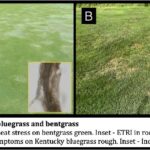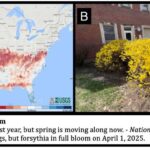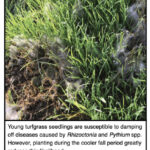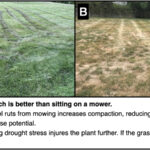Summer patch hits hard in early August; fall rust outbreaks causing orange shoes; cool temperatures allowing a head start on recovery plans. August in the region started cool, got back to summer hot, and now dare I say it feels like fall. This “false fall” in Indiana certainly is convincing as a stagnant high-pressure dome[Read More…]
Excessive and in some cases, abusive rainfall amounts; keys to soggy turfgrass management; winter injury potential causes and recovery, red thread, spring golf disease prevention Weather Spring, which officially started on March 20, is rolling along, and into mid-April temperatures in the region are ahead of statistical normal, but lagging somewhat behind last year. I[Read More…]
Summer 2024 was a stressful season for lawns in Indiana and throughout the region. Temperatures often spiked to uncomfortable levels, particularly towards the end of August, and were accompanied by either sweltering humidity or an abrupt halt to rainfall. Diseases such as brown patch on tall fescue were prevalent and leaf spot/melting out diseases on[Read More…]
Bill Walton, the legendary basketball player, sports announcer and perhaps the most outspoken and famous Grateful Dead fan, passed away in May leaving behind enough quirky quotes and euphemisms to make Yogi Berra proud. In a now viral clip since his passing, Mr. Walton reflects on teachings from his legendary coach and former Purdue basketball[Read More…]
Later this week, fall finally brings the respite of cooler temperatures and a much-needed drink of rainfall. While the cool-season species such as tall fescue and Kentucky bluegrass that dominate most of the Indiana lawnscape revel in this well deserved breather from disease pressure and high temperature stress, the metabolism of warm season plant species[Read More…]
The final month of summer is here, meaning children are returning to school and pools will be closing soon. The end of summer also signifies shorter days, cooler temperatures and a nearing finish line for the long marathon run by our cool season lawns. Summer is tough on the fescues, Kentucky bluegrass, and perennial ryegrass[Read More…]
As we get into the throngs of summer, disease activity takes hold on the cool season turfgrass species we commonly use on lawns. This spring/early summer 2023 much of the state has been in a considerable drought, missing approximately two inches of normal precipitation in both April and May, and three inches below normal so[Read More…]
Spring in all its wild weather swings, plant growth and flowering glory has arrived, and along with it, the chore of mowing the lawn. Many decry the labor and monotony, but evidently some do enjoy the practice, as a new video game allows one to mow a virtual yard even when rainstorms are thundering outside.[Read More…]
Pink snow mold is a disease caused by the fungal pathogen Microdochium nivale (syn. Monographella nivalis) that is being observed in middle and northern Indiana this late winter. The pathogen is termed psychrophilic, or cold loving, due to its propensity to grow and infect in colder temperatures. The disease can be particularly severe on unfrozen[Read More…]
Recently, home lawns have been maligned in several media outlets as a waste of time and resources. Mismanagement by using too much water or misplacing fertilizer may compound the issue by straining environmental resources or serving as pollutants. While not going into all the defenses for turfgrass use on home lawns, (remember “right plant, right[Read More…]
Ascochyta blight is a sporadic disease that can infect Kentucky bluegrass, tall fescue and perennial ryegrass. Outbreaks are closely tied to high rainfall or irrigation events in mid to late spring, and drainage patterns. If the lawn is irrigated, Ascochyta can be a sign of too much irrigation. Current rainfall events are providing a prime[Read More…]











